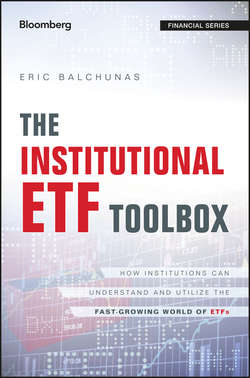Читать книгу The Institutional ETF Toolbox - Balchunas Eric - Страница 10
На сайте Литреса книга снята с продажи.
SECTION I
The ETF Phenomenon
CHAPTER 1
Why Are ETFs So Popular?
Liquidity
ОглавлениеLiquidity may not be the most attractive feature of ETFs for retail investors, but for institutions it is beloved. ETFs trade throughout the day like stocks. If an asset manager wants to buy mainland China at 2:13 P.M., they could punch up the Deutsche X-trackers Harvest CSI 30 °China A-Shares ETF (ASHR) and put in an order and own it within seconds. They could then sell it a minute later or year later.
This is much more expedient than using a mutual fund or hedge fund or owning the aforementioned SMA. None of those things can be gotten into and out of so quickly and easily. That’s why the liquidity advantage is really about freedom – something institutions don’t have a ton of. With ETFs you can buy and sell whenever you want without having to ask anyone’s permission. Institutions in particular value this trait because much of their existence is slow moving and waiting for boards to approve things and dealing with redemption schedules of managers and the like.
“It’s less paperwork. There are no gates. It’s just easy to do business with ETFs because they are exchange traded.”
Matt Goulet, Fidelity Investments
Since the financial crisis of 2008, institutions have been aware of the importance of liquidity in a portfolio. When it comes to liquidity, ETFs are now right up there with stocks. In fact, on any given day, ETFs will typically make up half of the top 10 most traded equities as shown in Table 1.3.
Table 1.3 Top 10 Most Traded Equities as of June 30, 2015
Source: Bloomberg
“Liquidity and precision are definitely the big benefits of ETFs.”
John Linder, Pension Consulting Alliance
A nice residual benefit of all this liquidity is that some ETFs end up costing less to trade than the basket of holdings they track. Some examples of this can be seen in Table 1.4. For instance, trading all the stocks in the Vanguard FTSE Emerging Markets ETF (VWO) would cost .21 percent, while VWO would cost .03 percent. You can also see that the iShares iBoxx Investment Grade Corporate Bond ETF (HYG) trades for significantly less cost than its basket. And yes, SPY trades so much that the spread is 0.004 percent, which rounds down to 0.00 percent, slightly less than the 0.03 for the Standard & Poor’s (S&P) 500 stocks. We’ll look at SPY’s freakishly high trading volume throughout the book.
Table 1.4 ETF Spreads versus Their Underlying Basket
Source: Bloomberg
This concept is referred to as “price improvement” and is one of the rare cases where you don’t have to pay more for convenience, but rather less. While this applies to only the most traded ETFs out there, it isn’t something lost on investors.
“I can go do a swap on a basket of securities. I can create my own custom basket. I can buy the index myself. But for us it comes down to does the ETF make more sense than going out and spending the physical capital. Usually, it does.”
Jim Dunn, Verger Capital Management
However, it should be noted that you can also get hurt trading ETFs if you aren’t careful or rack up some unwanted trading costs. We will dive deeper into ETF liquidity and trading in Chapter 5.
